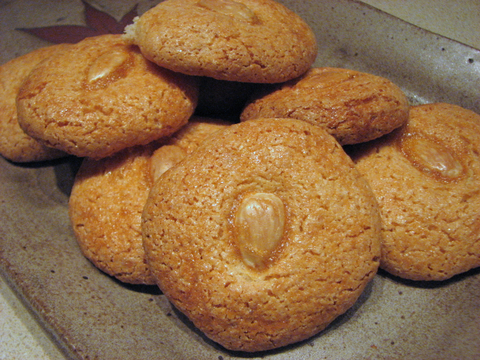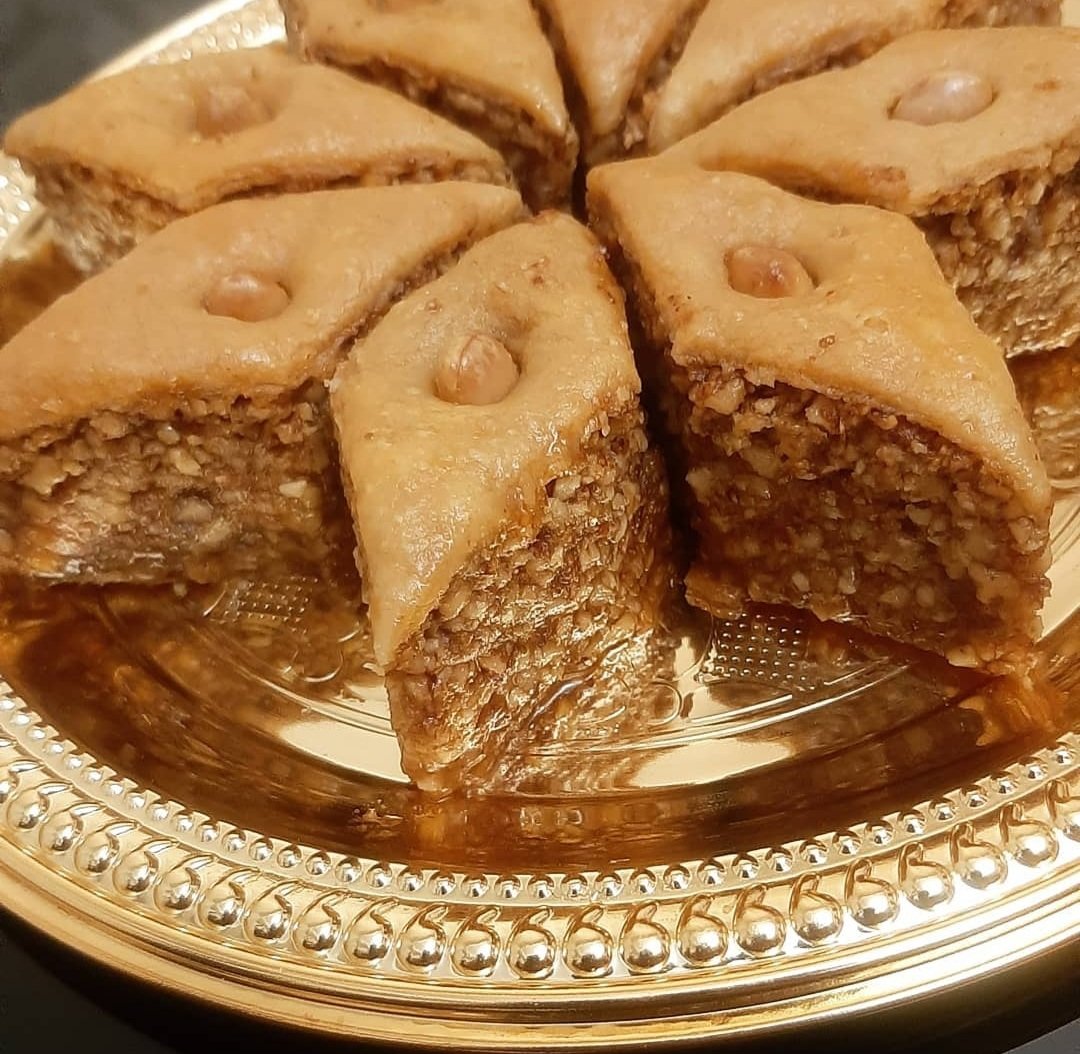|
Güllaç
Güllaç (pronounced ) is a Turkish dessert made with milk, rose water, pomegranate and a special kind of pastry. It is consumed especially during Ramadan. Güllaç is considered by some as being the origin of baklava. The similarities between the two desserts are many, such as the use of thin layers of dough. Güllaç dough is now prepared with corn starch and wheat flour, although originally it was made only with wheat starch. Güllaç contains walnuts between the layers that are put in milk. Its first known mention is in a 14th-century book, ''Yinshan Zhenyao'' (), a food and health manual written by Hu Sihui (), a physician to the Mongol court of the Yuan dynasty. The book documents primarily Mongol and Turkic dishes that exhibit a limited amount of Chinese influence. Güllaç was used for making ''Güllaç Lokması'' and ''Güllaç Baklavası'', old Turkish desserts made during the Ottoman period in Turkey. Etymology Turkish ''"güllaç"'' is thought to be loaned from ... [...More Info...] [...Related Items...] OR: [Wikipedia] [Google] [Baidu] |
List Of Turkish Desserts
This is a list of desserts from Turkish cuisine. See also * Outline of kadayif * List of desserts * Turkish cuisine References {{DEFAULTSORT:Turkish Desserts, List Of Turkish desserts, * Dessert-related lists Turkey-related lists, Desserts Cuisine-related lists ... [...More Info...] [...Related Items...] OR: [Wikipedia] [Google] [Baidu] |
Pomegranate Dishes
The pomegranate (''Punica granatum'') is a fruit-bearing deciduous shrub in the family Lythraceae, subfamily Punica, Punicoideae, that grows between tall. Rich in symbolic and mythological associations in many cultures, it is thought to have originated from Afghanistan and Iran before being introduced and exported to other parts of Asia, Africa, and Europe. It was introduced into Spanish America in the late 16th century and into California by New Spain, Spanish settlers in 1769. It is widely cultivated throughout West Asia and the Caucasus region, South Asia, Central Asia, North Africa, north and tropical Africa, the drier parts of Southeast Asia, and the Mediterranean Basin. The fruit is typically in season in the Northern Hemisphere from September to February, and in the Southern Hemisphere from March to May. The pomegranate and its juice are variously used in baking, cooking, juice blends, garnish (food), garnishes, non-alcoholic drinks, and cocktails. Etymology The name ... [...More Info...] [...Related Items...] OR: [Wikipedia] [Google] [Baidu] |
Turkish Pastries
Turkish cuisine () is largely the heritage of Ottoman cuisine (Osmanlı mutfağı), European influences, Seljuk cuisine and the Turkish diaspora. Turkish cuisine with traditional Turkic elements such as yogurt, ayran, kaymak, gains influences from Mediterranean, Balkan, Middle Eastern, Central Asian and Eastern European cuisines. Turkish cuisine shows variation across Turkey. The cooking of Istanbul, Bursa, İzmir, and the rest of the Anatolia region inherits many elements of Ottoman court cuisine, including moderate use of spices, a preference for rice over bulgur, koftes, and a wider availability of vegetable stews (''türlü''), eggplant, stuffed dolmas and fish. The cuisine of the Black Sea Region uses fish extensively, especially the Black Sea anchovy (''hamsi'') and includes maize dishes. The cuisine of the southeast (e.g. Urfa, Gaziantep, Adıyaman and Adana) is famous for its variety of kebabs, ''mezes'' and dough-based desserts such as ''baklava'', '' şöbiye ... [...More Info...] [...Related Items...] OR: [Wikipedia] [Google] [Baidu] |
Pomegranate
The pomegranate (''Punica granatum'') is a fruit-bearing deciduous shrub in the family Lythraceae, subfamily Punica, Punicoideae, that grows between tall. Rich in symbolic and mythological associations in many cultures, it is thought to have originated from Afghanistan and Iran before being introduced and exported to other parts of Asia, Africa, and Europe. It was introduced into Spanish America in the late 16th century and into California by New Spain, Spanish settlers in 1769. It is widely cultivated throughout West Asia and the Caucasus region, South Asia, Central Asia, North Africa, north and tropical Africa, the drier parts of Southeast Asia, and the Mediterranean Basin. The fruit is typically in season in the Northern Hemisphere from September to February, and in the Southern Hemisphere from March to May. The pomegranate and its juice are variously used in baking, cooking, juice blends, garnish (food), garnishes, non-alcoholic drinks, and cocktails. Etymology The name ... [...More Info...] [...Related Items...] OR: [Wikipedia] [Google] [Baidu] |
Turkey
Turkey, officially the Republic of Türkiye, is a country mainly located in Anatolia in West Asia, with a relatively small part called East Thrace in Southeast Europe. It borders the Black Sea to the north; Georgia (country), Georgia, Armenia, Azerbaijan, and Iran to the east; Iraq, Syria, and the Mediterranean Sea to the south; and the Aegean Sea, Greece, and Bulgaria to the west. Turkey is home to over 85 million people; most are ethnic Turkish people, Turks, while ethnic Kurds in Turkey, Kurds are the Minorities in Turkey, largest ethnic minority. Officially Secularism in Turkey, a secular state, Turkey has Islam in Turkey, a Muslim-majority population. Ankara is Turkey's capital and second-largest city. Istanbul is its largest city and economic center. Other major cities include İzmir, Bursa, and Antalya. First inhabited by modern humans during the Late Paleolithic, present-day Turkey was home to List of ancient peoples of Anatolia, various ancient peoples. The Hattians ... [...More Info...] [...Related Items...] OR: [Wikipedia] [Google] [Baidu] |
Yuan Dynasty
The Yuan dynasty ( ; zh, c=元朝, p=Yuáncháo), officially the Great Yuan (; Mongolian language, Mongolian: , , literally 'Great Yuan State'), was a Mongol-led imperial dynasty of China and a successor state to the Mongol Empire after Division of the Mongol Empire, its division. It was established by Kublai (Emperor Shizu or Setsen Khan), the fifth khagan-emperor of the Mongol Empire from the Borjigin clan, and lasted from 1271 to 1368. In Chinese history, the Yuan dynasty followed the Song dynasty and preceded the Ming dynasty. Although Genghis Khan's enthronement as Khagan in 1206 was described in Chinese language, Chinese as the Han Chinese, Han-style title of Emperor of China, Emperor and the Mongol Empire had ruled territories including modern-day northern China for decades, it was not until 1271 that Kublai Khan officially proclaimed the dynasty in the traditional Han style, and the conquest was not complete until 1279 when the Southern Song dynasty was defeated in t ... [...More Info...] [...Related Items...] OR: [Wikipedia] [Google] [Baidu] |
Fruit Desserts
In botany, a fruit is the seed-bearing structure in flowering plants (angiosperms) that is formed from the Ovary (plants), ovary after flower, flowering. Fruits are the means by which angiosperms disseminate their seeds. Edible fruits in particular have long propagated using the movements of humans and other animals in a Symbiosis, symbiotic relationship that is the means for seed dispersal for the one group and nutrition for the other; humans, and many other animals, have become dependent on fruits as a source of food. Consequently, fruits account for a substantial fraction of the world's agriculture, agricultural output, and some (such as the apple and the pomegranate) have acquired extensive cultural and symbolic meanings. In common language and culinary usage, ''fruit'' normally means the seed-associated fleshy structures (or produce) of plants that typically are sweet (or sour) and edible in the raw state, such as apples, bananas, grapes, lemons, oranges, and strawberries. ... [...More Info...] [...Related Items...] OR: [Wikipedia] [Google] [Baidu] |
Turkish Words And Phrases
Turkish may refer to: * Something related to Turkey ** Turkish language *** Turkish alphabet ** Turkish people, a Turkic ethnic group and nation *** Turkish citizen, a citizen of Turkey *** Turkish communities in the former Ottoman Empire * The word that Iranian Azerbaijanis use for the Azerbaijani language * Ottoman Empire (Ottoman Turkey), 1299–1922, previously sometimes known as the Turkish Empire ** Ottoman Turkish, the Turkish language used in the Ottoman Empire * Turkish Airlines, an airline * Turkish music (style), a musical style of European composers of the Classical music era * Turkish, a character in the 2000 film '' Snatch'' See also * * * Turk (other) * Turki (other) * Turkic (other) * Turkey (other) * Turkiye (other) * Turkish Bath (other) * Turkish population, the number of ethnic Turkish people in the world * Culture of Turkey * History of Turkey ** History of the Republic of Turkey * Turkic languages ... [...More Info...] [...Related Items...] OR: [Wikipedia] [Google] [Baidu] |
Persian Language
Persian ( ), also known by its endonym and exonym, endonym Farsi (, Fārsī ), is a Western Iranian languages, Western Iranian language belonging to the Iranian languages, Iranian branch of the Indo-Iranian languages, Indo-Iranian subdivision of the Indo-European languages. Persian is a pluricentric language predominantly spoken and used officially within Iran, Afghanistan, and Tajikistan in three mutual intelligibility, mutually intelligible standard language, standard varieties, respectively Iranian Persian (officially known as ''Persian''), Dari, Dari Persian (officially known as ''Dari'' since 1964), and Tajik language, Tajiki Persian (officially known as ''Tajik'' since 1999).Siddikzoda, S. "Tajik Language: Farsi or not Farsi?" in ''Media Insight Central Asia #27'', August 2002. It is also spoken natively in the Tajik variety by a significant population within Uzbekistan, as well as within other regions with a Persianate society, Persianate history in the cultural sphere o ... [...More Info...] [...Related Items...] OR: [Wikipedia] [Google] [Baidu] |
Ottoman Empire
The Ottoman Empire (), also called the Turkish Empire, was an empire, imperial realm that controlled much of Southeast Europe, West Asia, and North Africa from the 14th to early 20th centuries; it also controlled parts of southeastern Central Europe, between the early 16th and early 18th centuries. The empire emerged from a Anatolian beyliks, ''beylik'', or principality, founded in northwestern Anatolia in by the Turkoman (ethnonym), Turkoman tribal leader Osman I. His successors Ottoman wars in Europe, conquered much of Anatolia and expanded into the Balkans by the mid-14th century, transforming their petty kingdom into a transcontinental empire. The Ottomans ended the Byzantine Empire with the Fall of Constantinople, conquest of Constantinople in 1453 by Mehmed II. With its capital at History of Istanbul#Ottoman Empire, Constantinople (modern-day Istanbul) and control over a significant portion of the Mediterranean Basin, the Ottoman Empire was at the centre of interacti ... [...More Info...] [...Related Items...] OR: [Wikipedia] [Google] [Baidu] |
Baklava
Baklava (, or ; ) is a layered pastry dessert made of filo pastry, filled with chopped nuts, and sweetened with syrup or honey. It was one of the most popular sweet pastries of Ottoman cuisine. There are several theories for the origin of the pre-Ottoman version of the dish. In modern times, it is a common dessert among cuisines of countries in West Asia, Southeast Europe, Central Asia, and North Africa. It is also enjoyed in Pakistan and Afghanistan, where, although not a traditional sweet, it has carved out a niche in urban centers. Etymology The word ''baklava'' is first attested in English in 1650, a borrowing from . The name ''baklava'' is used in many languages with minor phonetic and spelling variations. The earliest known reference to baklava is in a poem by the 15th century mystic Kaygusuz Abdal. The historian Paul D. Buell argues that the word ''baklava'' may come from the Mongolian root ' 'to tie, wrap up, pile up' composed with the Turkic verbal ending ''-v'' ... [...More Info...] [...Related Items...] OR: [Wikipedia] [Google] [Baidu] |
Hu Sihui
Hu Sihui (, 和斯輝, 忽斯慧, also Hu Zheng Qi Huei; active nr. 1314–1330) was a Chinese court therapist and dietitian during Yuan dynasty. He is known for his book '' Yinshan zhengyao'' (''Dietary Principles''), that became a classic in Chinese medicine and Chinese cuisine. He was the first to empirically discover and clearly describe deficiency diseases. Biography The career of Hu Sihui, as he states in preface to his book, was in the reign of Buyantu Khan in Yenyu years (1314—1320). His ethnicity is unclear. He has been credited as of Mongol descent by some East Asian scholars, while Western scholars have pointed out his Turkic descent, his book being "far too comfortable with Turkic and a larger Islamic culture." He was an official in Xuanhui Yuan (the Ministry of Court Supplies and Provisions), around 1315 Hu Sihui initially emerged as the therapist of Empress Dowager, soon also became the therapist of the acting Empress, and later received the rank of the chief ... [...More Info...] [...Related Items...] OR: [Wikipedia] [Google] [Baidu] |







